Downloads
Check against delivery***
Introduction
It’s a pleasure to be here with you once again – and for a final time as the Secretary to the Treasury.
CEDA’s mission – to pursue good public policy to progress Australia's economic and social development – resonates deeply with Treasury. It is apt, therefore, that I am here to talk about some of the challenges and opportunities for Australia in achieving this goal.
Only two weeks ago, Australia hosted G20 Leaders in Brisbane. Among the outcomes was a commitment by the Leaders to implement measures that will boost global GDP by 2018 by at least 2 percentage points above what it might otherwise have been.
That commitment came in the context of a slow and uneven recovery from the Global Financial Crisis.
Forecasts for global growth have been downgraded again recently following a pattern that has become familiar over the past few years.
Forecasters keep expecting next year to be better than the current one, even while downgrading the current year outlook.
Revisions to IMF growth forecasts
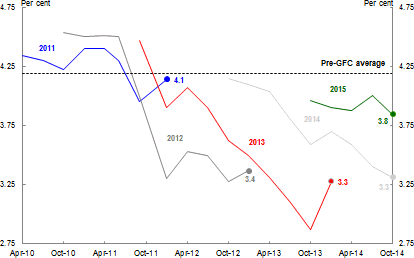
Note: Evolution of IMF forecasts for world growth (calendar year).
Source: IMF WEO
We now have a situation where 200 million people around the world are looking for work. As the IMF’s Christine Lagarde noted, if the unemployed formed their own country, it would be the fifth-largest in the world.
In Brisbane, Leaders acknowledged the need to work together – with the greater impact, beneficial spillovers and management of risks that collective action can produce – to stave off the threat of a “new mediocre” of poor growth and job creation.
The commitment to pursue greater growth was made by leaders of economies responsible for 85 per cent of global GDP, 75 per cent of world trade and two-thirds of the world’s population.
If implemented, the additional 2 percent growth is estimated to boost global GDP by around US$2 trillion – the equivalent of adding another Australia and New Zealand to the world economy over the next five years.
Delivering on this target will directly create millions of new jobs, indirectly benefiting many tens of millions around the globe.
This was the right choice in an increasingly interconnected world economy, where disappointing growth in systemically important countries or regions, shocks in financial markets, or increased geopolitical tensions, can affect the fragile global recovery.
It is no exaggeration to say that Brisbane was the most important economic meeting since the Global Financial Crisis was in full swing.
The meeting was important for Australia, and not just because we were hosting it.
The short-term outlook for our economy is dominated by its transition from resources investment-led growth and risks associated with continued weakness in the global economy and the potential for renewed financial instability.
Like other countries, we face the challenges of increasing productivity growth to support growth in incomes and of returning public finances to a sustainable position, where an ageing population will make the tasks of achieving both income growth and fiscal sustainability more challenging.
Along with other G20 members, in Brisbane, Australia reiterated its commitment to reform policy settings to remove constraints on the economy’s efficiency and dynamism, and to better position us to deal with the reality of radical shifts in the global economy – including shifts in the centre of global growth away from the West toward rapidly growing emerging markets and developing economies.
The reality of a global economy undergoing radical shifts demands the adaptation of policy, irrespective of countries’ individual experiences during the Crisis.
What the G20 process has highlighted is that deeper international cooperation, driven by need in the aftermath of the Crisis, will also enable countries to better manage the longer-term challenges we have in common and, in doing so, help position us to make the most of the opportunities driven by these shifts.
In the rest of this address, I would like to reflect a little more on what the G20 is seeking to achieve in the wake of the Crisis; the challenges in navigating Australia’s transition from the resources boom to broader-based growth; and the opportunities we have to improve the resilience and dynamism of our economy, positioning ourselves to gain from the shifts in world economic activity favouring our region.
Reflections on G20
In Brisbane, Leaders made a number of significant commitments in addition to the growth target, including on female participation, the stability of the global financial system, trade, energy market governance and taxation. Let me talk about a couple of these briefly.
On the growth target, Leaders were acutely aware that it was not only important to commit to decisive action to support growth, but that, to an extent, this action had to be coordinated. This is because the policy responses to the crisis have created new sources of vulnerability for growth and global stability.
Never before in peacetime have countries bought into a commitment akin to this target. They did so knowingly and willingly because they recognised that it will take collective action to avoid being trapped in a slow-growth rut, with all of its attendant social and economic consequences.
The Crisis led to rapid accumulation of public debt, and fiscal authorities in many countries remain reluctant, and have neither the political support nor market tolerance, to stimulate their economies.
In ‘normal’ times, countries might employ monetary policy to offset fiscal austerity, supporting demand by lowering interest rates and boosting domestic economic activity through exchange rate depreciation.
Even when multiple countries pursue this course of action, and exchange rates remain unchanged, demand might still be supported by a lower global interest rate.
What we now have, however, is a world where many countries have reached a zero lower bound to interest rates. Countries that rely solely on austerity measures therefore run the risk of simply lowering demand and employment, with commensurate consequences for the tax revenues and fiscal balances, which the measures were supposed to support.
Many countries have employed quantitative easing to offset this effect, but we are yet to see the massive increase in funds this has generated translate into growth-inducing investment.
With easing measures driving down returns on relatively ‘safe’ assets – like government bonds – investors have increasingly taken on more risk to bolster returns. This is leading to elevated prices across a range of equity and credit markets – as was intended, for such a rise in asset prices is needed to induce new investment. But it is also creating new risks.
Obviously, the longer prices for assets are elevated above their fundamental worth, the greater the risk of a disruptive reversal down the track.
Unfortunately, to again quote Madame Lagarde, we are seeing too much financial risk-taking and not enough economic risk-taking.
In some large Eurozone countries, for example, Italy, investment has fallen around 30 per cent below pre-crisis levels and continues to decline. For the G20 as a whole, the IMF estimates that investment is nearly 20 per cent below its long-term trend.
Monetary policy needs to stay accommodative to support demand in the near term. But continuing risks to financial stability mean it is important to pursue financial sector reform alongside policy measures that will promote sustainable economic growth.
It is fo
r this reason that G20 Leaders endorsed significant measures to strengthen the global financial system – substantially completing the process of reform designed to help ensure the circumstances that led to the Crisis do not re-occur.
Leaders also recognised that, while fiscal and monetary policy may be able to support demand in the short-term, they cannot underpin long-term growth. In February in Sydney, G20 members agreed that structural reforms to create the right circumstances for substantial private sector-led growth were critical, and this common position was reflected in their individual growth strategies released in Brisbane.
Individual countries’ strategies to support growth range from employment measures to infrastructure investment, to resolutions to expand trade, increase competition and productivity.
Two areas of particular attention for coordinated action are investment in infrastructure and work on tax base erosion and tax evasion.
G20 members focussed on supporting investment in infrastructure as a means of managing the short and longer-term challenges of promoting growth while undertaking fiscal repair. In this regard, they noted the benefits of investing in expenditure are threefold:
- it supports aggregate demand during construction;
- if done well, it augments the economy’s supply capacity and boosts productivity for the long term; and
- if priced appropriately, it may even help the fiscal position in the medium term.
Australia, of course, has understood this for a while, which is reflected in the current year’s Budget and initiatives to reform the governance of infrastructure.
G20 members also agreed to coordinate efforts to prevent tax base erosion and profit-shifting, recognising that, in an environment of increasingly connected and sophisticated arrangements of economic activity, we need to ensure that tax systems remain effective and tax burdens are not unduly borne by those who cannot design their affairs to avoid tax.
Australia led the G20 process conscious that it has fared well relative to other advanced economies in the past few years and, indeed, over the past few decades through episodes like the Asian Financial Crisis, the bursting of the technology bubble and subsequent US recession, and the Global Financial Crisis.
Even a country like Australia, which missed much of the fallout from the Global Financial Crisis, recognised that continuing reform at home is needed if we are to weather shocks in the future while pursuing the opportunities opening up to us by the rapid growth and development in our region.
Challenges and opportunities in the short term
Let me start with challenges and opportunities over the short term.
As you know, Australia’s growth over the past decade has largely been driven by a boom in demand for our commodity exports, which led to significant increases in resource sector investment and boosted our terms of trade, contributing to higher average incomes.
Contributions to income growth
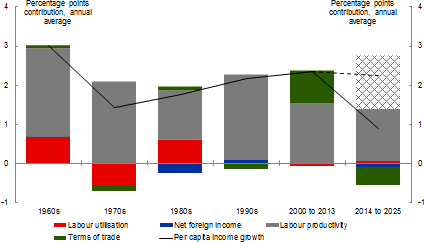
Note: The hatched area represents the additional labour productivity required to achieve long run average growth in real gross national income per capita.
Source: ABS cat. no. 5204.0 and Treasury.
The resources boom is now shifting from an investment phase to production, and this adjustment is being borne out in two interrelated ways: in the adjustment in the real economy as resources investment declines, and in a weakening of national income growth as the terms of trade declines.
The economy needs to shift to broader sources of growth in the economy. As I have noted many times, this will not be seamless.
The mining sector has doubled as a share of GDP in the past decade. Investment in the resources sector as a share of GDP quadrupled over the past decade.
By the end of this financial year, the stock of capital in the resources sector is expected to be four times higher than it was at the start of the mining boom. That investment has, in turn, fuelled a rapid growth in output, the result being that the sector has been the key driver of growth for some years now. But that momentum is rapidly diminishing.
Contributions to GDP growth
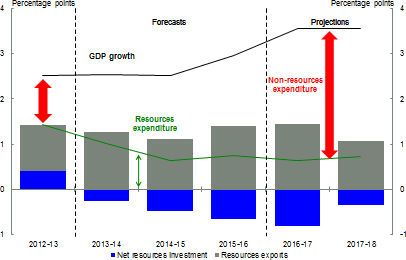
Note: Assumes that mining investment has an import share of 50 per cent.
Source: ABS cat. no. 5204.0, 5302.0, BREE and Treasury.
The transition to broader sources of growth in the economy is occurring but perhaps more slowly than we may have expected. In particular, the exchange rate has not depreciated as much as we might have expected, given the recent weaknesses we have seen in key commodity prices – so the boost to domestic non-mining producers is also less than might have been anticipated.
The continuation of unconventional monetary policies in the major advanced economies is likely to be a contributing factor, with Australia remaining an attractive destination for global investment flows.
More generally, consumers continue to show caution in spending. Businesses, in turn, appear unwilling to invest without signs of resurgence in consumer activity, and this is critical for rebalancing growth.
Recent domestic economic developments indicate that the economy will continue to grow at a below-trend pace in the near term before growth in the non-mining sectors starts to significantly pick up. If this were to eventuate, GDP would have grown below trend for 7 of the 8 years to 2015-16, resulting in the creation of a sizeable output gap.
Real GDP forecasts
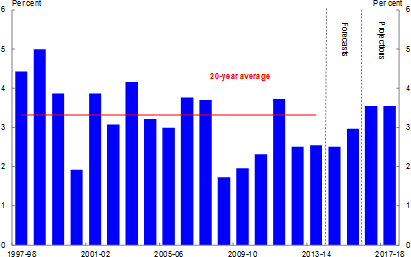
Source: ABS Cat. No. 5204.0 and Treasury.
Output and unemployment gap estimates (deviation from trend)
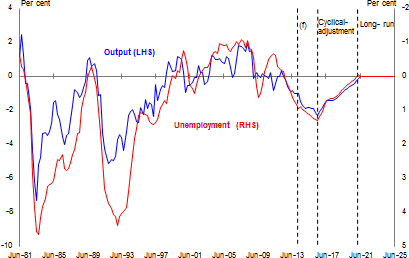
Source: Treasury.
While the economy performs below its potential, a key risk is that the economy will not generate enough jobs growth to absorb new entrants to the labour market.
The risk in this scenario is not so much that the unemployment rate rises – this has largely already occurred. We want to avoid the risk that cyclical unemployment develops into structural unemployment, which would create significant social and economic costs, were this to eventuate.
The flipside is that wages growth has been moderate, which will help with the transition to non-mining sources of growth and is a sign that the labour market is adjusting flexibly, although it is also likely to be dampening consumption.
Taking an international perspective, a key short-term challenge is managing the process of ‘normalising’ monetary policy when global growth remains uneven and weak.
Given the growth outlooks for most advanced economies, this is likely to be a slow process. Moreover, there are significant differences between market expectations and policy makers’ expectations of recovery, particularly in the US, raising a risk of disruption in financial, credit and exchange rate markets when these are re-aligned.
The divergence in monetary policy settings in the major advanced economies – with the US Federal Reserve having concluded its asset purchase program while the European and Japanese central banks continue to expand their own – also has implications for the major currencies, including, indirectly, Australia’s.
Central bank assets-to-GDP
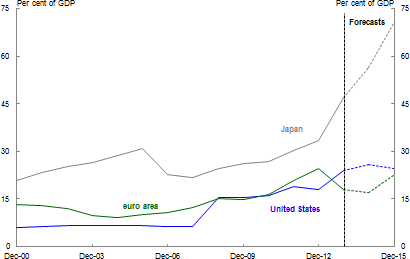
Source: Treasury.
It is always important that markets provide the appropriate signals to support transitions.
In Australia, the exchange rate will continue to be particularly important.
It played an important part in helping the economy adjust during the mining boom by drawing resources to that sector, and its adjustment will be equally important in supporting investment and spending in the non-mining sectors. In turn, this activity will help increase employment and reduce the risk of cyclical unemployment ‘hardening’ into structural unemployment.
Further depreciation, together with low interest rates and slow wages growth, will provide conditions overall that are supportive of growth.
That we are so well-placed is a testament to the reforms pursued over the past three decades, which gave us stable institutional frameworks and general flexibility in our labour, capital and product markets.
The mining boom does, however, remind us of a perennial policy lesson: that we need to think about our policy settings consciously given changes in our environment. Australia is now much more exposed to cyclical fluctuations in commodity prices. This suggests we need our floating exchange rate to be supported by greater flexibility in labour and product markets.
It is also likely to challenge traditional relationships between real and nominal GDP, with ramifications for revenue collection. As such, it also raises a question of whether fiscal policy needs to be tighter during periods of higher commodity prices than in the past to help smooth activity when commodity prices are low.
Let me now turn to longer-term domestic challenges and opportunities.
Longer-term challenges and opportunities
On a number of occasions, I have talked about the drivers of global change as the shift in economic weight to our region, technological developments, and the challenges posed by sustainability and climate change.
In addition to this, we have an apparent slowing in the rate of productivity growth in many advanced economies and ageing populations. The UN has pointed out that, in less than a decade, the over-65s will outnumber the under-5s for the first time ever. This will reduce workforce participation rates, and therefore potential growth in GDP and living standards, and is likely to raise demand for government services.
With that in mind, it is worth considering the opportunities presented by the shift in centres of global growth and how this may impact on the key domestic challenges of improving our productivity growth and returning the fiscal balance to a sustainable position.
Emerging markets and developing economies have grown to make up slightly more than 50 percent of global GDP (on a PPP basis) and, on reasonable assumptions, are expected to increase their share to more than 60 percent of world GDP within the next ten years.
By 2050, four of the 5 largest economies in the world will be in our region – China, India, Japan, and Indonesia.
Australia has already benefited from these shifts, as evidenced by demand for our mineral commodities from the resources boom. The more fundamental shift in our trading interests over the past 10 years or so can be seen in these charts, which compare which countries we exported to in 2003-04 and 2013-14.
In 2003-04, 23.3 per cent of our exports went to the Anglosphere – the US, UK and New Zealand. In 2013-14, this was 10.8 percent. Over that decade, the fastest-growing export market was China, which went from receiving 8.5 per cent of our exports to 32.4 per cent.
Export destinations
2003-04
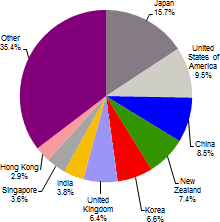
2013-14
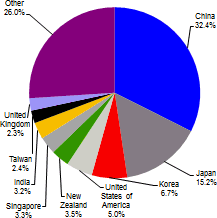
Source: ABS Cat. No. 5368.0 and 5368.0.55.003.
I have spoken in the past about the emerging middle class in China, India, Indonesia and other populous countries, as the next source of global growth in consumption. In this decade – and for the first time in 300 years – we will see the number of Asian middle-class consumers equal the number in Europe and North America.
This middle class – which is expected to grow from around 500 million people in 2009 to around 3.2 billion by 2030 – is likely to increase its demand for a wide range of goods and services.
Estimated size of middle class by region
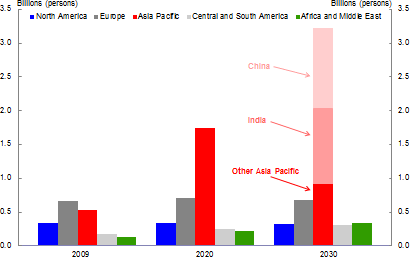
Source: 'Kharas, H. and Gertz, G. (2010) The New Global Middle Class: A Cross-Over from West to East.
Some Australian industries – including education and agriculture – are already benefiting from this demand. Education exports to Asia, particularly to China, India and ASEAN, have increased threefold since the beginning of the century.
China has become our largest source of overseas students (around 150,000 enrolments in 2013) and our second-largest source of tourists (almost 760,000 in 2013-14). Economic growth in Asia is also likely to continue driving demand for Australia’s resources and agricultural commodities.
Short term visitor arrivals in Australia
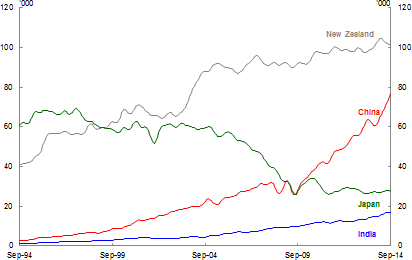
Source: ABS Cat. No. 3401.0. Data are monthly.
But unlike in resources and commodities, Australia has no inherent comparative advantage in the services sector writ large. As I have noted before, Beijing is closer to Berlin than Brisbane. If we are to grasp these opportunities, we will need to work for them, and work hard. There are no grounds for complacency.
Fortunately, we are at a juncture where our decisions over the next few years can help shape our future for the next decade and beyond.
We have the opportunity with the reviews of our tax system, our workplace relations system, the ‘root and branch’ reviews of our financial markets and competition framework, and the review of the functioning of our federation, to make decisions that improve our productivity growth and to position ourselves to reap the most from future prospects.
Public sector reform will also be important. Increasingly, with the ageing of the population and the growing size of our services industries as a proportion of the economy, how well the public sector delivers or contracts services like health and aged care will have a bearing on budget outcomes, as well as the productivity of the economy as a whole.
Achieving a more sustainable fiscal position is also critical.
As I have said before, Australia has a structural budget problem that requires a sustained and measured response. While this year’s Budget contained measures to improve fiscal balance and reduce the negative impacts of some programs on economic growth, they have prompted considerable debate.
Ultimately, fiscal policy involves trade-offs.
Countries spend and tax to achieve particular social objectives.
However, we would be dishonest with the public if we pretended that Australia could ensure fiscal sustainability with the pace of expenditure growth implied by the policies of recent years, without a significant increase in the national tax burden. It would also be dishonest to suggest that raising taxes is costless – ultimately somebody has to pay - and, if those taxes are inefficient, th
e negative impact on growth is magnified.
Government payments to GDP
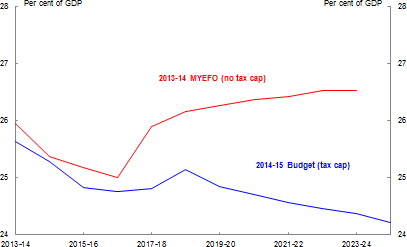
Note: A tax-to-GDP cap of 23.9 per cent has been applied to 2014-15 Budget projections. There is no tax cap on 2013-14 MYEFO projections.
Source: 2014-15 Budget.
Tax and expenditure policies ultimately come down to the social welfare choices of Parliaments, but I would offer three points of guidance drawn from economics and experience.
Firstly, from a growth perspective, focusing on reducing government spending is generally preferable to raising the overall tax burden.2
Obviously, changes within the mix of taxes that improve the efficiency of economic outcomes for any given amount of revenue are desirable, as is focusing more on expenditures with long-term payoffs, like well-targeted investments in infrastructure and human capital.
Secondly, it’s not feasible to materially reduce spending growth without looking at the largest spending categories. For the Commonwealth, this is health, welfare and higher education.
Whenever Parliament reverses, in part or in full, transfers provided to sections of the community by their predecessors, the savings inevitably come from those who were previously the recipients of those transfers. While it is important that the public debate acknowledge that these sectors of the community are losing a benefit bestowed on them by a previous Parliament, it is also important to recognise the materiality of that loss, and to draw a distinction between reducing current transfers and reducing the future real growth in those transfers.
Third, it is important that we start the process of fiscal consolidation now.
Australia has recorded 23 years of consecutive growth and the budget projections are based on an assumption that this will continue for a further decade. Such an outcome – 33 years of uninterrupted growth - would be without precedent, domestically or globally.
Yet even on this assumption, we know the Budget is likely to remain in deficit in each and every one of the next 10 years unless we take action.
Fiscal position pre- and post-Budget
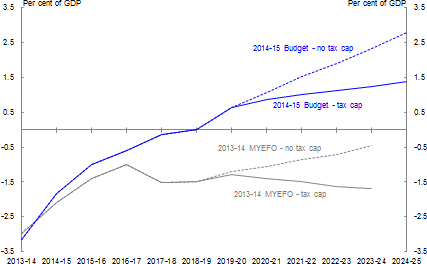
Source: 2014-15 Budget.
The implications for fiscal sustainability of failing to take action seem to have been lost in the public debate, as if this does not matter to Australia’s future prosperity.
Moreover, fiscal drag, which helps improve fiscal outcomes in the pre-Budget line of this chart, is regressive yet gets little attention. As I have noted elsewhere, allowing fiscal drag to continue will result in someone on average full-time earnings moving into the second-highest tax bracket from 2015-16 and, over the decade ahead, experiencing a rise in their average tax rate of over 20 per cent.
Personal income tax rates and the effects of fiscal drag
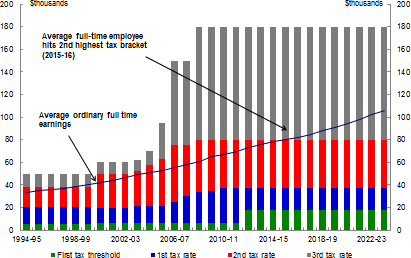
Note: Based on Budget 2014-15 parameters.
In contrast to the focus of our public debate, comparator countries are lowering personal and corporate income taxes, and shifting the tax mix in favour of more efficient tax bases, in order to better compete globally. The consequence for Australia of maintaining a 1950s tax mix in the 21st century should be self-evident.
Conclusion
I have highlighted some of the short and longer-term challenges and opportunities for Australia, noting the enormous opportunities that are open to us, particularly from the shift in economic weight to our region, if we meet the challenges head on.3
The decisions we take as a nation in the next few years will help determine whether we succeed or fail to ride the wave of opportunity open to us.
The public needs to be engaged in this debate, and to appreciate the trade-offs that result in success or failure.
We know what failure looks like: declining growth in living standards, perhaps even falling living standards, lower wages, few opportunities for our young and, in all likelihood, declining public services and rising personal tax burdens as we struggle to maintain an outmoded industrial structure in an increasingly globalised world.
But such an outcome is far from inevitable.
Australia is in the fortunate position of having very sound institutions, a history of reform, and a willingness to continue adapting if we are persuaded by the need for change. So rather than being pessimistic about the future, we have strong grounds for optimism. Over the next few years, we have a unique confluence of opportunities to put Australia on a path to a more prosperous, sustainable future, to the benefit of all Australians.
I have had the privilege of working in Treasury during a remarkable 30 years of reform and growth in Australia. I am very optimistic about our prospects, and I look forward to the next era of growth and change.
Thank you for inviting me here to speak today.
1 I would like to express my appreciation to Angela Woo, David Drage, Jenny Wilkinson, Nicholas McMeniman and Marty Robinson for their assistance in preparing these remarks. Due to time constraints, it was necessary to summarise across a range of areas in the version delivered to CEDA in Melbourne. This is the complete version of the speech.
2 Obviously there can be exceptions to this, such as when a tax brings the private costs and social costs of an action closer together, for example the taxation of tobacco.
3 Many of the matters I have touched on today have been explored in depth in other addresses I have given whilst Treasury Secretary.